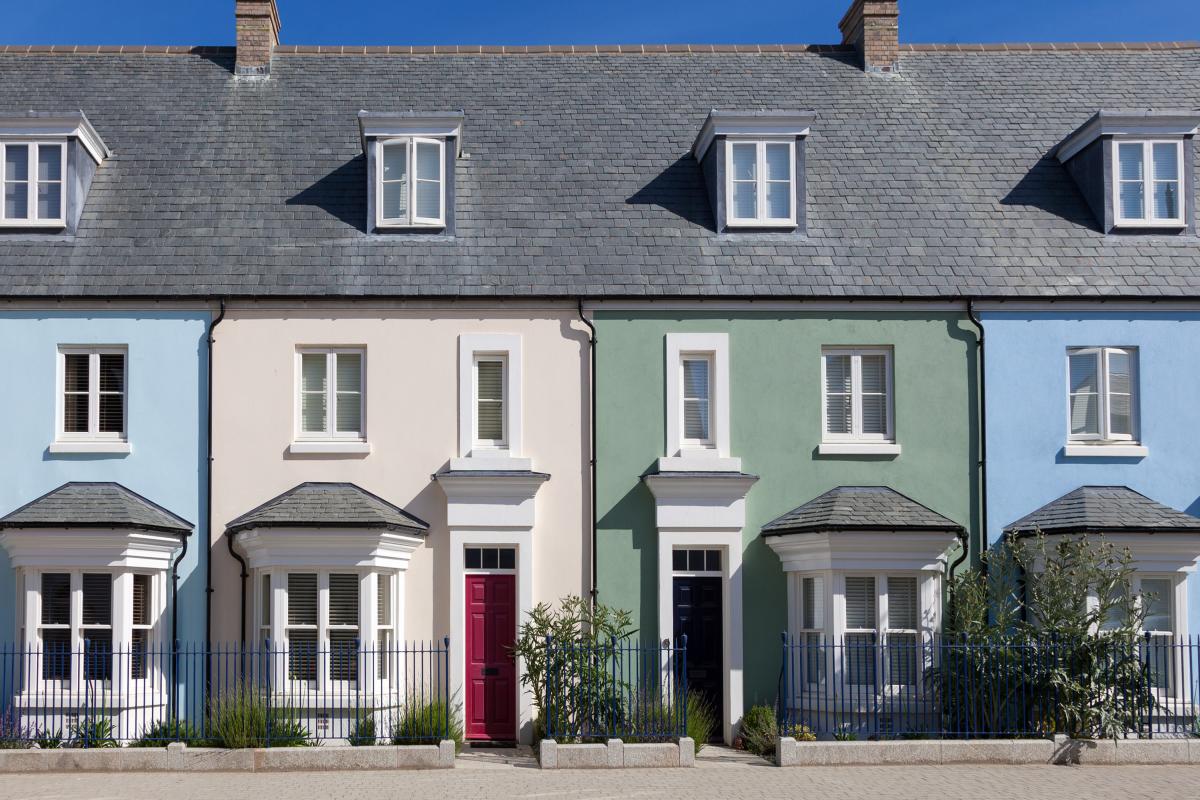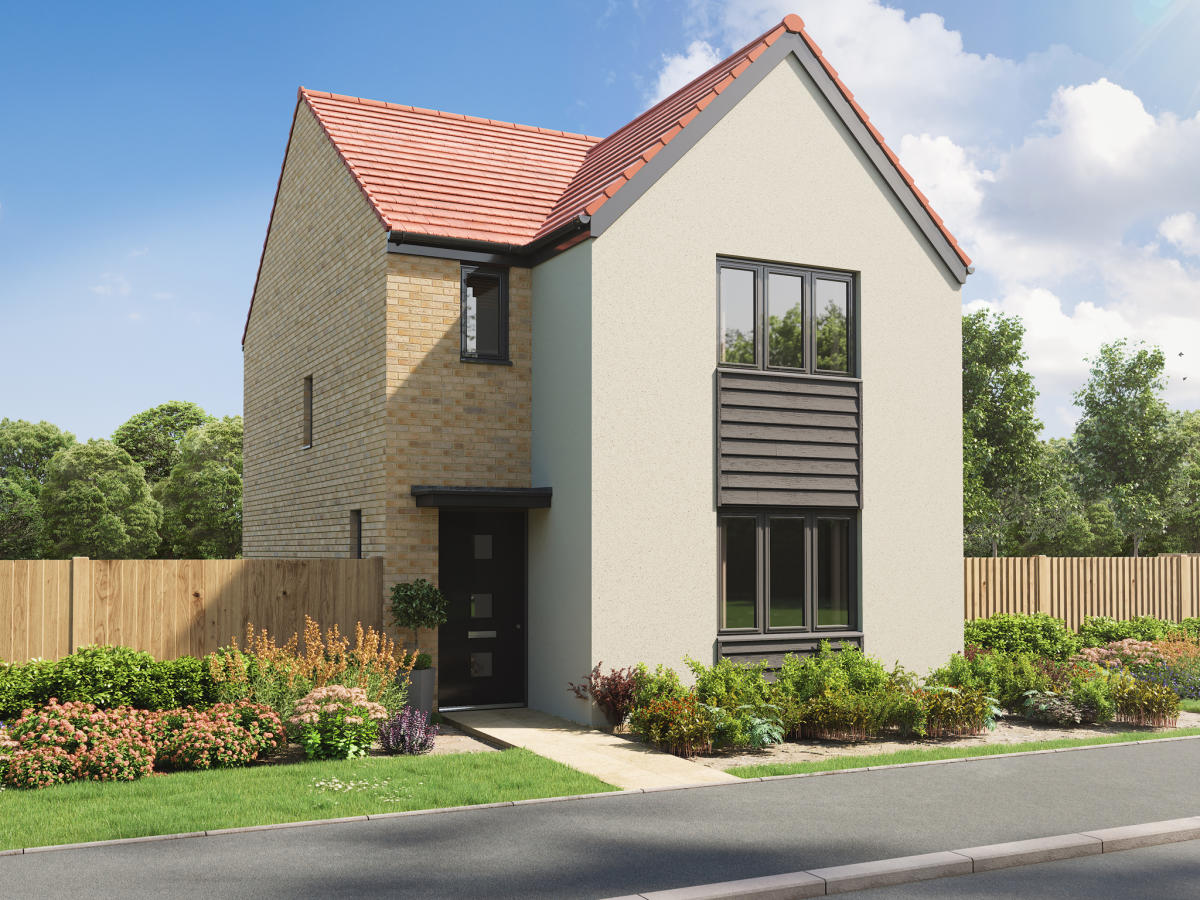Pandemic housing boom creates 270,000 property millionaires
Demand for property was up nearly 60% over the last two years, while supply drained to 40% below the norm. Which meant only one thing: house prices increased as the nation got moving.
Nearly 10m homes shot up by £50,000 in value over the last two years, as the pandemic created levels of demand from buyers not seen since 2006.
The average home went up £48 a day as the world entered a new phase of flexible working from home, freeing up home buyers to shop further afield in new locations.
Demand was so high, running at 58% above the five-year average, that supply levels took a hit, with the number of homes for sale falling to 40% below the five-year average.
This, in turn, pushed house prices higher at rates not seen for 16 years, as buyers competed to secure the homes of their dreams.
Total value of UK homes passes £10 trillion mark
For the first time, the total value of the UK's 29.5m homes has surpassed the £10 trillion mark, as £1.3 trillion was added to the property market during the course of the pandemic.
The overall value of UK homes now stands at £10.1 trillion.
Where the biggest value rises were seen across the country
| Region | Value of housing today | Value pre-pandemic | Change in value | Average property value |
| Wales | £335bn | £274bn | 22% | £201,000 |
| South West | £965bn | £803bn | 20% | £320,000 |
| North West | £765bn | £636bn | 20% | £192,000 |
| East Midlands | £569bn | £476bn | 19% | £235,000 |
| Yorks and Humber | £547bn | £460bn | 19% | £186,000 |
| West Midlands | £671bn | £573bn | 17% | £225,000 |
| North East | £213bn | £182bn | 17% | £144,000 |
| South East | £1,879bn | £1,633bn | 15% | £394,000 |
| Eastern | £1,109bn | £964bn | 15% | £350,000 |
| Northern Ireland | £143bn | £125bn | 15% | £158,000 |
| Scotland | £493bn | £435bn | 13% | £164,000 |
| London | £2,398bn | £2,248bn | 7% | £516,000 |
| UK as a whole | £10,088bn | £8,809bn | 15% | £266,000 |
Homes in Wales saw the greatest increase in value since the pandemic began in February 2020, with house prices up 22% on average.
Wales was hotly followed by the North West and South West, where prices rose by 20% in both areas.
In London, which lagged behind the rest of the country both in terms of demand and price rises throughout the pandemic, the increase was just 7%.
That’s less than half the national average increase, mainly because the average property in London costs 11.5 times the average salary, putting property prices way above the rest of the country.
The ability to work from home also dented demand for homes in the capital - and particularly demand for apartments.
The high value inner areas of London were hit too as the world came to a standstill.
With no city buzz to enjoy, home hunters began searching for more space in idyllic locations by the sea or in the countryside instead.
Despite that, when looking at the whole of the UK, London and the South East still account for 23.5% of the total value of our housing.
However, that share has fallen from 26% pre-pandemic.
One in three homes shot up in value by more than £50,000
Of the UK's 29.5m homes, nearly a third, or 9.4m, have grown in value by more than £50,000 since the start of the pandemic.
Our data shows the UK's more affordable regions saw the biggest gains, as flexible working opened up the housing landscape to buyers.
Executive Director says, "An exodus of older workers from the labour market over the pandemic, together with more working from home, is driving more households to look further afield for their next home to get greater value for money."
That said, where homes are already more expensive, gains could also be seen.
London and the South East account for over 3m of these rising properties, while in the South West, nearly 2m grew by more than £50,000.
A further 9.4m homes across the country increased by £25,000-£50,000 in value.
How homes went up in value across the UK
| Price change | Number of homes | % of UK homes |
| Unchanged or lower | 1.7m | 6% |
| Increase up to £25K | 8.8m | 30% |
| Up £25K - £50K | 9.4m | 32% |
| Up £50K - £75K | 4.6m | 16% |
| Up £75K - £100K | 2m | 7% |
| Up £100K or more | 2.9m | 10% |
Value of Housing Report
"The gains over the last year are the largest since 2006 but they are far from uniform," says Donnell.
"Every homeowner experiences the impact of the market through the changing value of their own property.
"Rising home values unlock new opportunities for homeowners considering their next move."
But there have also been losses in value across the UK
A total of 1.6m homes (that’s 5.7% of the total housing market) have either stayed the same price or lost value since the pandemic began.
Of these, 800,000 have seen a value decline of 5% or more.
These homes can mostly be found in inner London, where the impact of the pandemic has hit travel, working patterns and demand for homes.
Westminster, Kensington & Chelsea, Islington, Hammersmith & Fulham, Tower Hamlets and Southwark all suffered losses in the capital, accounting for 28% of that 800,000 - or 224,000 homes.
In Scotland, Aberdeen and Aberdeenshire, where the economy suffers from the historic decline in oil prices, accounted for a further 6% of homes declining in value - or 48,000 homes.
"Not everyone has seen home values increase," says Donnell.
"Affordability is holding back prices in London and southern England and our analysis reveals the centre of gravity of the housing market is shifting northwards.
"The largest gains in value are being seen in more affordable areas where there is further room for price growth, even with modest increases in mortgage rates."
Key takeaways
- A third of UK homes went up by more than £50,000 during the pandemic
- In rises not seen since 2006, 270,000 homeowners have now joined the millionaires' club
- The average UK home has earned £48 a day since February 2020
8 ways to tell if your home is winning the value race
We’re not saying it’s a competition. But you might be winning. Want to know if your home’s gaining value faster than a mate's?
House prices have shot up at rates unseen since 2006 in the last two years. In April, the UK’s average house price reached £250,000 for the first time ever.
But not all homes and areas are equal.
Keen to find out if yours is a hot property?
Here are seven ways to tell if your place is winning in the house price race.
1. Keep an eye on their home
It’s not stalking. It’s keeping an eye on the market.
At Zoopla, you can get track any home to get the latest price estimate.
And you can see how its estimate has changed over the last two years.
Track as many homes as you like, any time you like, for as long as you like.
And we’ll send you the new price estimate every month.
Job done.
2. Track your home
Be proud. It’s yours and you love it. You might have put a lot of work into it.
And you must be wondering how your bricks and mortar is performing in value.
And if your area's on the up? And if everyone wants a property like yours?
So tell us you own it.
We’ll show you the rest.
3. See what’s for sale nearby
Who doesn’t love a little nosy around the neighbours’ house?
Well, we can do better than that.
We can let you know the asking price of any home that comes up for sale in your area.
Or if they’re not for sale, we’ll show you what they last sold for. Whether it was last week or last decade.
After all, it just provides a good benchmark for yours, right?
4. Keep up with the housing market
It’s good to have a feel for what’s right when it comes to property.
The more you get to know the market, the more your instincts will take over when it comes to knowing what a home’s worth.
There’s no secret to it. It’s just about staying in the loop.
It’s a snapshot of what’s going on across the country. You’ll be a property expert in no time.
5. Find out what improvements they’ve made
As you run your fingers over their new marble kitchen worktops, you might be wondering how much value that work has added.
But what really ups the price of a home? A landscaped garden, a brand new bathroom or a kitchen extension?
6. Eye up their kerb appeal
A home that looks great from the outside could really give it the edge in the house price race.
It’s all down to that first impression.
But who’s dressed to impress, and who’s left dead in the water?
7. Suss out their home’s style
Major developers don’t get interior designers to stage their homes for nothing.
Stylish decor is thought to add up to 10% to a home’s value.
A few tweaks could help you edge ahead in the house price stakes.
8. Get an estate agent’s opinion
If you want to know exactly what your home’s worth, there’s only one way to know for sure.
We’ve got loads for you to choose from, and they’ll know your local market like the back of their hand.
They might even be able to choose a winner.
6 ways to make your house a smart home
Smart home tech can help you save time, money and energy – plus it can add value to your home. Here's how to turn your house into a smart home.
45% of people in the UK already have smart home technology. And it’s expected to hit nearly 85% by 2026, according to Statista.
It’s not going away any time soon. But is smart tech really all it’s hyped up to be?
Let’s take a look at the benefits of smart home tech and how you can turn your house into a smart home.
First of all, what is a smart home?
A smart home is a house with electrical items that are connected to the internet. They’re all linked up to your phone and each other through Wi-Fi, 4G or Bluetooth.
This means you can control appliances and monitor usage through your phone.
As well as switching things on and off, you can set schedules and triggers for a group of connected devices.
So you could set your smart speaker to recognise “Good morning”, and it would get the coffee brewing and your favourite radio station playing. All before you get out of bed.
Or you could set the oven to warm up and the heating to come on when you leave work. It’ll be all ready for you when you get home.
Smart home appliances all come together to help you save time, energy and money.
What are the benefits of a smart home?
1. Smart tech helps you save on energy
You might be looking to reduce your impact on the environment or keep your energy bills down.
Smart devices can help you save energy by turning appliances on and off as you need them.
It won't matter if you forget to turn the lights or heating off when you leave the house. You can just do it on your phone instead.
2. It can help keep your home safe and secure
Keeping your home safe and secure is a great benefit of smart technology.
You can keep an eye on things while you’re away and set triggers to deter burglars.
Surveillance cameras can ping you if they detect movement outside your home.
You can run smoke and CO2 detectors from your phone too.
3. It's convenient
A lot of people like smart home technology because it makes life easier.
You can set appliances to turn on and off in line with your daily routine. And change their schedule just as your plans change.
4. Smart tech can add value to your home
A home with integrated smart tech will often have a higher value than a similar non-smart home.
Many buyers are looking for more convenient ways to live, and smart home integration does just that.
Energy efficiency is also high on the list for buyers, and smart homes can help keep energy usage to a minimum.
6 ways to make your house a smart home
1. Choose your smart ecosystem
The smart ecosystem lays the foundations for your smart home.
Think of it as the network for your smart devices and appliances. If they’re all designed to work on the same network, they’ll work better together.
Apple, Google and Amazon are behind the three main ecosystems at the moment. They all have similar features, so it’s down to personal preference.
Keep in mind that most smart devices are designed for a particular ecosystem. It’s not always easy (or possible) to use a device designed for Apple as part of an Amazon ecosystem.
2. A smart speaker
The next thing you’ll want to get is a smart speaker.
A smart speaker means you can control all smart aspects of your home with your voice.
Choose the speaker that fits with your ecosystem – so Alexa for Amazon, Google Nest for Google or Apple HomePod for Apple.
You can then turn things on and off with just a word or phrase.
Or you can then set up rules to trigger multiple actions from your speaker at one time.
3. Smart plugs
Smart plugs are an easy and affordable way to make your home smart, without buying loads of new appliances.
A smart plug can turn an ordinary lamp, coffee machine or TV into a smart appliance. Once they’re plugged in, you control them from your phone or speaker.
Just like smart appliances, you can schedule smart plugs to turn on and off with your schedule.
You can label your smart plugs too. So if you ask Alexa to turn the kettle on, it’ll know which plug you’re talking about.
4. A smart heating system
A smart heating system is one of the best choices to save on energy bills.
86 per cent of users claimed a smart meter has helped them reduce their spending, according to The Coexperts.
You connect your phone to the smart thermostat and get total control over your heating.
Some smart heating systems can work off the GPS location of your phone. So it could tell when you’re nearly home and turn the heating on for you.
Or it could detect when you leave the house and automatically turn the heating off and save you energy.
Smart heating systems can also give advice on how you can use less energy. They can suggest automations to help you manage your home’s temperature.
5. Smart lighting
Smart light bulbs are another popular smart home product.
Smart light bulbs are very energy efficient and they’re fairly easy to install.
You replace your normal light bulbs with smart ones and connect them to your smart ecosystem.
The cheapest smart light bulbs will allow you to control the lights from your phone. You can set rules to turn them off as you leave the house or when it’s time for bed.
More expensive versions change colour or connect to your TV. If connected to a TV, smart lighting can automatically match the mood of a film or programme you’re watching.
6. A smart security system
Smart cameras are a great way to boost the security of your home. They can also make sure you don’t miss deliveries.
A video doorbell is a popular and easy to use option. It uses a camera to pick up if someone’s outside your house.
A livestream from the camera then feeds through to your phone.
If security's a concern for you, you can add more features to a smart security system. You could incorporate motion sensors around your home and garden, as well as sirens and door and gate locks.
A local estate agent can give you the most accurate estimate of your home’s value.
If you’ve got smart home tech – or are thinking about adding it – they can let you know how it changes your home's value.
Key takeaways
- Smart home technology can make your home safe, secure and energy efficient
- You can control appliances and energy usage through your phone
- Choose a smart home ecosystem and smart speaker to lay the foundations for your smart home
- Add smart appliances or just start with smart plugs to turn ordinary items into smart ones
7 ways to improve your home's EPC rating
Rising energy bills and a hunger for greener living mean a good EPC rating is now more important than ever. Here’s how to get one for your home.
An Energy Performance Certificate (or EPC) rating is essentially a review of a property’s ability to use energy efficiently.
All homes must have an EPC certificate when being sold or made available for rent.
The certificate is valid for 10 years.
What’s a good EPC rating?
An EPC certificate rates a property’s energy performance through a grading system of A to G, with A being the most efficient and G being the least.
A property with an EPC rating of C or above is generally thought to be pretty good. The average home in the UK has a rating of D.
New-build homes generally have higher scores, as they tend to be around 60% more energy efficient than older homes.
Buildings with higher EPC ratings are more popular with buyers and renters, especially in today’s climate of astronomically growing energy costs, as they’re cheaper to run.
From December 31, 2025, all landlords must make sure the buildings they are letting out to tenants carry an EPC rating of C or above.
You can find out the EPC rating of every property listed for sale or for rent on Zoopla on our listings pages.
Or, if you’re interested in a property that’s not currently on the market, you can find out their EPC rating through the government’s website.
How is an EPC rating decided?
An EPC rating is carried out by a government-approved energy assessor.
They look into the amount of energy a home uses per square metre and how much carbon dioxide it produces.
The average household produces 6 tonnes of CO2 annually.
The assessor conducts a measured survey of the property, examining the lighting, heating and hot water systems.
The certificate they produce then shows the current costs for running the home - and the potential costs if the assessor’s recommended energy-saving improvements are made.
It will also show the property’s overall rating from grades A to G.
What factors affect an EPC rating?
The assessor will look at whether the home has:
- energy efficient bulbs
- double glazed windows
- an energy efficient boiler
- thermostats for the home and individual radiators
- log, coal or gas fires
- loft and wall insulation
- pipes and water tank insulation
- renewable energy sources such as solar panels
- air/ground source heat pumps
- water-saving systems - such as dual-flush loos
How can I improve my EPC rating?
1. Use energy efficient light bulbs
They can cut lighting costs by up to 90%, so are well worth the investment.
2. Insulate your loft
It will help to prevent up to 25% of your heating escaping through the roof.
3. Consider cavity wall insulation
It can help to stop 35% of your heating from leaving your home and only takes a couple of hours to install.
Holes are drilled into the external walls of your property and insulation is injected into the cavity.
4. Replace your old boiler with an energy efficient new one
It could make a drastic difference to your fuel bills - and your EPC rating.
5. Invest in double or triple glazed windows
6. Seal any draughty parts of the house
Including floorboards, around windows and the front door.
7. Consider using an environmentally-friendly air/ground source heat pump
Is there financial help available to improve my EPC rating?
Yes, there is.
Energy companies will pay for insulation, glazing and even new boilers for people claiming certain benefits under the Energy Company Obligation scheme.
The Boiler Upgrade Scheme offers property owners £5,000 towards the cost of buying and installing an air source heat pump or biomass boiler.
Grants averaging £10,000 are also available to certain households to make energy efficiency improvements under the Green Homes Grant Local Authority Delivery Scheme.
Can I change my EPC rating?
If you think your EPC rating is wrong, you can contact the assessor who gave the home its rating.
Their name will be on the EPC certificate that was issued for the property.
You can ask them to reassess the property based on where you think the errors might have been made.
If you’re still concerned that an error has been made, you can appeal to the assessor’s accreditation scheme. The details for this can also be found on the EPC.
The rising cost of energy
In April this year, the energy price cap increased by 54%, meaning a typical household’s energy bills went up by around £700 a year from £1,300 to £2,000.
In October that price cap is set to rise again, taking the average household’s energy bills to just under £3,000.
After October, Ofgem is set to change the price cap every three months and bills are expected to remain high until October 2023.
Ensuring your home is as energy efficient as possible is now more important than ever, whether you’re looking sell, rent or stay put.
A few improvements now could save you hundreds of pounds in the long run.
Key takeaways
- Energy efficient light bulbs, double glazing and a decent boiler can all improve a home's EPC rating
- Insulation, thermostats and dual flush loos also help
- In October this year, the energy price cap will rise to just under £3,000. So anything you can do to improve your home's energy efficiency now is worth doing
If you’re looking to sell, now’s the time
As the housing market starts to slow, if you’re looking to sell your home, now’s a good time to do it.
The average UK property price has remained broadly unchanged this month, rising by just 0.1% since May, according to our latest House Price Index.
That’s the lowest rate of monthly price growth since December 2019, while the quarterly growth of 1.4% is the slowest since March 2021.
Year on year, property prices are up 8.4%, down from +9.2% in April and the rapid house price growth seen across the UK since the start of the pandemic has finally peaked.
Demand for properties still remains strong at 40% above the five year average, but that demand is beginning to decline week on week, as the market returns to more ‘normal’ conditions.
With that in mind, sellers looking to capitalise on gains made during the pandemic-driven property boom should act sooner rather than later.
The proportion of listings where asking prices have been reduced is also rising.
One in 20 properties (or 5.1%) showed a reduction of 5% or more in May. That's up from 4.7% in April.
The average price reduction is 9%, which, when applied to the average property price, equates to a discount of around £22,500.
That said, the number of new sales agreed is 21% above the five year average, showing there is still plenty of appetite among buyers, so now is still a good time to sell.
Gráinne Gilmore, Head of Research at Zoopla says: “Buyer demand is still strong in the housing market, but signals are emerging that the impetus may be easing, so those who want to make a move should investigate their options sooner rather than later.
“In addition, mortgage rates are likely to continue to climb, so locking into a rate shortly could save hundreds over the longer-term.
“There are many factors supporting the price growth seen since the start of the pandemic, not least the continued imbalance between demand and supply, but the increasing cost of living, increasing mortgage rates for buyers and cloudier economic outlook will act as a brake on house price growth through the rest of the year.”
Where properties are being snapped up right now
Wales continues to be the hottest UK property destination, registering the highest price growth yet again at +11.4% year on year.
While this is down from a high of 13.4% in February, homes in Wales have risen by an average of £32,000 in the last 24 months, taking the typical house price to £192,500.
Homes are also selling like hotcakes in the South West, where properties are taking just 19 days to sell, subject to contract, from first being listed.
The South West has been basking in high levels of demand since the pandemic began, as buyers swiftly prioritised rural and coastal settings as their places of preference.
A similar picture is emerging in Bournemouth, where price growth is up 10.2%, making it one of the cities with the highest levels of growth in the year leading up to May 2022.
That said, these speedy sales are expected to slow this year, as buyer demand for homes in the South West is seeing one of the sharpest declines over the last month, down 16%, despite demand for houses remaining 37% above the 5-year average.
Across the UK, the average time to sell (that’s the time between when a property’s first listed and when it becomes sold, subject to contract) is rising.
It’s now 22 days for May compared with 20 days in March, while the time it takes to get to the point of exchange is now averaging around 170 days - around five and a half months.
All of this suggests that buyers who want to move this year should consider putting their home on the market now.
Demand for holiday homes on the up
The holiday lettings industry has also played its part in boosting buyer demand since the pandemic began.
Around one in five purchases in the South West in 2020-21 were additional dwellings.
In the North of England, this figure was 26%, while in the capital it was 29%.
Where the property market’s a little cooler…
London continues to show the slowest price growth, with average property prices up +3.9% year on year, rising £30,000 over the last 24 months to £516,100.
Homes in London are currently taking the longest time to sell at 35 days.
The London market has been lagging behind the rest of the UK since the pandemic began, with the capital showing the humblest levels of house price growth since February 2020.
However, the tide is turning for the city. Buyer demand remains higher than the 5-year average - and 35 days to sell is significantly lower than the five year average of 50 days for May.
Meanwhile, prices in Aberdeen are down 2% on the year, a decrease of £6,400 over the last 24 months, meaning the average house price is now £140,200.
What do higher interest rates mean for house prices?
As the cost of living continues to bite, mortgage rates are rising as the Bank of England increases interest rates in an attempt to combat rising inflation.
Buyers are facing average rates of 3.37% for a five-year fixed-rate £250,000 loan now (with a 25% deposit), compared to 2.64% in December.
That means the annual cost of a £250,000 loan has increased by £870.
If five-year mortgage rates continue to rise by more than another basis point, taking them to around 4.62% (levels last seen in April 2010), the annual cost of a mortgage repayment would climb by £2,500, compared to December 2021.
If you’re a homeowner looking to move in the next two years
The rate of house price growth is expected to slow to 3% through the rest of the year, with prices rising at less than half the rate registered last year, where they were up 8.4%.
However, property prices are unlikely to decline as demand for housing remains high, despite falling back from record levels.
And the stress-testing for mortgages introduced since the global financial crisis means that many homeowners have proved their income can withstand rising interest rates.
That means the number of forced sales, which have a negative impact on pricing, is likely to remain limited.
The recent announcement that stress testing rules will be adjusted for borrowers, so they’ll no longer have to prove they can afford repayments at the Standard Variable Rate +3%, will mean some additional borrowers will be able to access loans, especially first-time buyers.
Mortgage affordability rules relaxed by Bank of England
However, the move is unlikely to make a significant change to lending levels, as the general rule for lending to be limited to 4.5 times a borrower’s income remains in place.
Plus, the majority of homeowners are also locked into a fixed-rate mortgage, meaning they are protected from the current interest rate moves.
Fortunately, the UK is currently enjoying a buoyant employment market, helping to offset the more challenging inflation environment for now.
Where is the market going in the next 3-6 months?
House price growth remains strong by any measure. The levels of annual growth seen over the last couple of months are the highest since late 2016.
However, there are now signs that the market is beginning to ease, despite demand levels remaining 30% above the five year average, as that demand is beginning to fall back from record peaks.
The market is still moving very quickly, but the time between listing a home for sale and that sale being agreed is starting to creep up, as the market returns to more normal conditions.
The economic outlook, and multiple base rate rises, are expected to lead to slower activity throughout the rest of this year.
That said, 1.2 million homes are expected to change hands across the UK in 2022.
Should I delay buying a home?
If you’re looking to buy a home, it’s best not to delay. House prices will continue to rise this year, albeit at a slower pace than we’ve seen over the past two years.
And Interest rates are likely to continue to increase, as the Bank of England tries to combat rising inflation, making borrowing more expensive.
If you’re looking to get a new mortgage or to remortgage, it’s best to choose a fixed rate option with the lowest possible interest.
Key takeaways
- House price growth is starting to slow with property prices remaining broadly unchanged since last month
- As the cost of inflation continues to bite, property prices are showing the lowest monthly price growth since December 2019
- Buyer demand is still 40% up on the five year average, but is starting to gradually decline, so sellers should act quickly to capitalise on recent gains
Mortgage affordability rules relaxed
The latest move by the Bank of England to relax mortgage affordability rules should make it easier for first-time buyers to take out a mortgage.
The Bank of England has announced plans to relax mortgage lending rules from August 1 in a major boost for first-time buyers.
Borrowers currently have to show they would be able to afford repayments if their mortgage reverted to their lender's higher variable rate and interest rates jumped by 3%.
But after consulting lenders and other members of the industry, the Bank’s Financial Policy Committee (FPC) has said it will scrap the rule this summer.
The change is great news for first-time buyers, who were most likely to have been caught out by the rule.
It comes at a time when rising interest rates and high house prices are already making it challenging for people to get on to the property ladder.
Why was this rule introduced?
A number of new affordability guidelines were introduced for lenders in 2014 to protect the banking system from high levels of debt following the financial crisis in 2008.
The FPC called on lenders to make sure borrowers could still afford their mortgage repayments when their fixed rate deal ended and if interest rates rose.
As a result, lenders had to make sure that monthly repayments were still affordable if borrowers were moved on to their reversion rate – typically known as the standard variable rate – and interest rates rose by 3%.
The FPC also asked lenders to limit the number of mortgages they offered to people borrowing 4.5 times their income to 15% of their total lending.
Why is it being scrapped now?
When the rule was introduced, interest rates were expected to rise to 2.25% in the coming five years.
When the FCA first launched its consultation around lifting the rule, it seemed highly unlikely that interest rates would hit this level in the years ahead.
As a result, the FCA thought the test was no longer needed.
But since then inflation has soared to a 40-year high of 9%, causing the Bank of England to raise interest rates five consecutive times to 1.25%.
While that is still well down on the 2.25% anticipated when the test was introduced, interest rates are now expected to rise to 3%, or possibly higher, next year.
The average standard variable rate is already just under 5%. If interest rates rise by a further 1.5%, borrowers would have to show they could afford a mortgage rate of 9.5%.
For example, if someone was borrowing £180,000 on a two-year fixed rate mortgage with an interest rate of 2.5%, their monthly repayments would be £815.
But they would have to prove that they could still afford their mortgage if the interest rate was 9.5% and their repayments were £1,590 a month – almost double the amount they would actually pay.
Such a tough test would exclude many people from taking out a home loan.
While the FCA has not commented on this issue directly, it is thought to be one of the reasons it is withdrawing the rule so quickly after the consultation concluded.
Officially, it has said that the rule limiting the proportion of customers who can borrow more than 4.5 times their income and other affordability checks are enough to ensure lending is responsible.
Who does it benefit?
The decision to withdraw the rule is good news for homeowners who have borrowed a relatively high proportion of their salary and would need to remortgage in the next few years.
It is particularly good news for first-time buyers, who typically have lower salaries and smaller deposits, making them more likely to struggle with the test.
Capital Economics estimates that when the stress test interest rate was 6.6%, the typical mortgage customer was able to borrow five times their income.
But if the rate used for the stress test hit 9.5%, the maximum amount they could borrow would drop to just four times their income.
Around one in four people currently borrow more than four times their income, so if the rule had stayed in place, many people would have struggled to get a mortgage.
Key takeaways
- The Bank of England has announced plans to relax mortgage lending rules from August 1
- Borrowers currently have to show they can afford repayments on their lender’s higher variable rate if interest rates rose by 3%.
- The change is great news for first-time buyers, who were most likely to have been caught out by the rule
Mortgage lenders told to do more to help struggling borrowers
The Financial Conduct Authority has called on lenders to work harder to understand the cost of living problems people are facing. And to ensure they are offered the right support.
Mortgage lenders have been told to do more to help customers who are struggling with repayments in the face of rising interest rates.
Regulator the Financial Conduct Authority (FCA) has written to more than 3,500 lenders calling on them to take the time to understand individual customers’ circumstances and offer tailored solutions.
It warned that lenders should also only charge fees that are fair and cover their own costs.
In addition, the FCA said they should encourage mortgage customers to switch to less costly options where these were available, as well as helping them to access free debt advice.
The call was directed at all types of lenders, including those who offer mortgages, credit cards and loans.
Sheldon Mills, executive director of consumers and competition at the FCA, said: “Many consumers are feeling the impact of the rising cost of living in their personal finances and we expect this to increase over the next few months.
“Early action is important for those struggling with debt. We need all firms to get the basics right and provide good quality support.”
The letter comes as the Bank of England increased interest rates for the fifth consecutive time, raising the official cost of borrowing to a 13-year high of 1.25%.
Interest rates rise to a 13-year high
The move means two million homeowners on variable rate mortgages will see their monthly repayments rise by a cumulative £114 a month since interest rates first began to increase in December.
Why is this happening?
The FCA said they had looked into how borrowers in financial difficulties were being treated by lenders.
They found that some lenders were not providing the right support.
The FCA was particularly concerned that the most vulnerable customers were not being given the right advice.
It pointed out that with household bills expected to continue to rise into the autumn, it was important that firms put measures in place to ensure they were offering the best help to struggling customers.
What should I do if I’m struggling?
The regulator urged borrowers who were struggling to talk to their lender as soon as they can.
The FCA said lenders must offer a range of short-term and long-term options to mortgage customers who were facing difficulties.
These include:
- extending the mortgage term to make monthly repayments more affordable
- changing the mortgage type, such as converting from a repayment mortgage to an interest-only one
- offering a payment holiday, to give customers breathing room to get their payments back on track
But it stressed that this list was not exhaustive, and lenders should consider other options under appropriate circumstances.
What’s the background?
Despite the pressures households face from the rising cost of living, it should not impact the amount mortgage customers can borrow, according to research carried out by mortgage trade body UK Finance.
It found that while rising prices had led to homeowners facing a 3% reduction in their disposable income, they would still qualify for the same sized mortgage now as they did last year.
The finding is good news for borrowers, as they face strict affordability tests which look at their day-to-day outgoings when they take out a mortgage.
It suggests that people looking to remortgage should still be able to borrow the same amounts as they could before the cost of living hike.
Key takeaways
- Mortgage lenders have been told to do more to help customers who are struggling with their repayments
- The regulator, the Financial Conduct Authority, has told lenders to take the time to understand individual customers’ circumstances and to offer tailored solutions
- Lenders should also only charge fees that are fair and cover their own costs
Interest rates rise to a 13-year high
Nearly two million homeowners will face higher mortgage repayments after the Bank of England increased interest rates for the fifth consecutive time.
The Bank of England has increased interest rates for the fifth consecutive time, lifting the official cost of borrowing to a 13-year high.
Its Monetary Policy Committee increased the Bank Rate from 1% to 1.25% as it continues to battle the rising cost of living.
Three members of the committee voted to raise interest rates by an even more aggressive 0.5%, suggesting there will still be further increases to come.
The move means around two million homeowners with variable rate mortgages will see their monthly mortgage repayments rise.
The latest increase will add around £24 a month to a £200,000 mortgage, bringing the cumulative increase since rates first started to rise to £114 a month.
It comes at a time when consumers are already suffering from steep increases in food, petrol and energy costs.
Why is this happening?
Like many central banks around the world, the Bank of England is increasing interest rates in a bid to control inflation, which measures rises to the cost of living.
Inflation as measured by the Consumer Prices Index is currently running at 9%, its highest level for 40 years, and it is expected to hit 11% later this year.
To put this in context, the Bank of England is supposed to keep inflation at around 2%.
High inflation is currently a global problem due to a combination of high energy and fuel prices, which impact the cost of goods, disruption to the supply chain caused by Covid-19 and the conflict in Ukraine.
Who does it affect?
Not everyone will be impacted by the latest increase.
Nearly three-quarters of homeowners have a fixed rate mortgage, and they will not see any change to their monthly repayments until their current deal ends.
But the news is less good for those with a variable rate mortgage.
Around 850,000 people are currently on a tracker mortgage, with a further 1.1 million on a standard variable rate one.
These homeowners will see their monthly repayments increase by around £24 a month if they have a £200,000 mortgage, adding to the previous increases they have already seen since December.
What should I do now?
If you are coming to the end of a fixed rate mortgage, start looking for a new deal now.
Although the interest rate rises seen since December will already have been priced into new deals, further increases are expected in the months ahead.
You can ‘book’ a mortgage offer up to six months in advance of your current deal ending.
With rates only heading in one direction, try to line up a new deal as soon as possible.
You should also look for a new mortgage of you are currently on your lender’s standard variable rate.
The average interest rate charged on standard variable rates is currently 4.91%, meaning you could save £189 a month if you switch to a typical two-year fixed rate product of 3.25%, based on a £200,000 mortgage.
If you are on a tracker deal, which moves up and down in line with changes to the Bank Rate, it may not be possible to remortgage without paying early redemption penalties.
Check with your lender to find out if this is the case. If you can exit your current deal without penalties, you may want to consider remortgaging onto a fixed rate deal to protect yourself from further interest rate rises.
Economists are predicting the Bank Rate could rise to 3% next year.
If you are struggling to pay your mortgage, contact your lender as soon as possible.
There are a number of steps they can take to help you, including giving you a temporary payment holiday or putting you on to an interest-only mortgage for a short time.
But options become more limited if you have already missed a payment.
Key takeaways
- The Bank of England has increased interest rates five times in a row, lifting the official cost of borrowing to a 13-year high
- Yesterday, the Bank Rate increased from 1% to 1.25% , increasing monthly repayments by around £24 a month for someone with a £200,000 mortgage
- If you're on a standard variable rate or tracker mortgage, it's a good idea to fix now, as interest rates are likely to go up again over the coming months
New-build buyers driving the green home movement – and saving up to 52% on energy costs
Climate change and the cost of living are making energy efficiency a priority for new-build buyers, but many people underestimate how much money you can save with a greener home.
New research shows that the cost of living and climate change are creating new priorities for home buyers.
This is particularly the case for new-build buyers, who are prioritising energy efficiency in their buying decision.
And while new-build buyers are driving the green home movement, almost half of buyers of older homes still see energy efficiency as important.
High EPC ratings top of the wishlist for new-build buyers
Energy efficiency is now a high priority for those who bought or intend to buy a new-build home.
More than two-thirds of new-build buyers (69%) said EPC ratings were either extremely or very important to them.
The energy efficiency of new-builds is a growing attraction for buyers. More than 80% of new-builds have an energy efficiency rating of A or B, compared to just 3% of older homes.
“Rising energy costs and greater awareness of climate change are starting to have greater influence on home buying decisions,” said Richard Donnell, Research Director at Zoopla.
“The energy efficiency of new homes and the lower running costs is a recognised attraction for would-be buyers compared to those looking for a home in the resale market.”
You can save up to 52% on your energy bills with a new-build home
We’ve taken a look at the government’s EPC data, and you can save a huge amount by moving to a home with a higher EPC rating.
New-builds offer up to 52% lower running costs over a year compared to a similar-sized older property.
The average carbon output of a new home also comes in at under a third of that from an older home (1.4 tonnes vs 3.8 tonnes per year).
Other research has found similar energy savings for new-build owners.
New-build owners save an average of £629 a year on energy bills, according to the Homes Builders Federation.
But lots of people don’t realise how much you can save by moving to a new-build home.
When asked to estimate how much money a new-build could save you on energy bills over a year, 6 in 10 respondents thought it would be less than 52%.
And a third of people thought you’d only save 20% on energy bills in a new-build compared to a similar older home.
Buyers care about the environmental impact of building a new home
New-build buyers are also conscious of the environmental impact of building a new home.
Three quarters (74%) of new home buyers said it was important that their home is built with minimal impact on the environment.
What’s next in the green home movement?
This is just the start of decarbonising the housing market and reducing emissions from UK homes.
The introduction of new government regulations has seen an increase in the energy efficiency requirements of new homes.
The Future Homes and Buildings Standard ensures that new homes built from 2025 will produce 75-80% less carbon emissions than those delivered under current regulations.
This will mean massive energy savings for homeowners.
While buyers of older homes are less concerned about the energy efficiency of their home at the moment, 2 in 5 (41%) still said it's important to them.
“We expect the importance of energy efficiency to increase further as the Government continues to roll out further policies," said Richard Donnell.
“The new homes market and the private rented sector are the big focus areas for policymakers at present.”
“Rising energy costs will only serve to increase the importance of energy efficiency and running costs of homes as part of home moving decisions.”
Surveyed 2,615 people between 28 February 2022 and 10 March 2022. Respondents had either bought a home in the last 18 months or intend to buy one over the next 18 months.
Key takeaways
- Rising living costs and growing climate change concerns are creating new priorities for home buyers
- Nearly 70% of new-build buyers say energy efficiency is an extremely or very important factor in their home
- New-builds can save you 52% on energy costs over a year – but most people think it’s less
Extra protection and powers for renters announced in Renters Reform Bill
Changes will protect renters from rent rises, ensure homes are fit to live in and make it easier to have a pet.
Renters are set to be protected from unfair rent increases as part of a package of reforms to improve the private rented sector.
New rules being introduced will also end ‘no fault’ evictions, while all rental homes will have to meet minimum standards, the government said.
Other changes include making it illegal for landlords to have blanket bans on families with children or people receiving benefits, and it will also be easier for renters to have pets.
The government claims the measures, which will be included in the Renters Reform Bill to be introduced during the current parliamentary session, are the biggest shake up for the private rented sector for 30 years.
Richard Donnell, Executive Director of Research and Insight at Zoopla, said: “With the backdrop of the cost of living crisis putting pressure on renters, these reforms are welcome and timely, particularly as they’re largely focused on boosting the quality of housing in the rented sector.
“The private rented sector plays an important role in the housing market, providing much needed homes for a wide spectrum of households. These reforms mark another milestone in the journey to create a suitable equilibrium between renters and private landlords who provide the majority of homes for rent.”
What will change?
Under the new rules, arbitrary rent review clauses will be outlawed, and notice periods for rent increases will be doubled. Renters will also have stronger powers to challenge rent rises if they think they are unjustified.
To ensure all private rented properties are fit for occupation, the Decent Homes Standard will be extended to cover the sector for the first time.
If homes fall below this standard, people will have their rent repaid. Councils will also have stronger powers to tackle rogue landlords, including larger fines for serious offences.
Going forward, all renters will be moved into a single system of ‘periodic tenancies’, enabling them to leave poor quality housing without remaining liable for the rent, and making it easier for people to move if their circumstances change.
Section 21 ‘no fault’ evictions will also be banned, meaning tenancies will only end if a renter wants them to, or the landlord has a valid reason, defined in law, to do so.
Meanwhile, all renters will have the right to ask to have a pet in their home, and their landlord must consider their request and cannot unreasonably refuse it.
A new Private Renters’ Ombudsman will also be created to settle disputes between renters and landlords quickly and at a low cost, while renters will be able to demand information on their landlord and rate them.
Why is this happening?
The government claims the measures will help to redress the balance between landlords and the 4.4 million people who rent homes in the private sector.
While the majority of renters have safe homes, the government wants to help the 21% of people who rent in the private sector have properties that are deemed to be unfit, more than half of which pose a risk to renters’ health and safety.
It also wants to protect renters from ‘no fault’ evictions, after research showed more than a fifth of private renters who moved in 2019 and 2020 did not do so by choice.
Who does it affect?
The move is great news if you rent in the private sector, as it offers you greater certainty over how long you can live in your home and how much it will cost you.
You also have the reassurance that your home will meet minimum standards and that you have an easy route to take action if disputes occur between you and your landlord.
But there are concerns that the measures could lead to more landlords exiting the sector.
A growing number of amateur, private landlords have sold their properties in recent years as a result of tax hikes and increased regulation, which have made the market less profitable.
This trend has led to a growing mismatch between supply and demand, forcing rents higher.
Donnell said: “There is a delicate balance to ensure reforms don’t compound these supply-side challenges, which continue to keep an upward pressure on rents.
"Rents have risen 11% in the last year. Ensuring decent homes is paramount but so is the investment into this important sector of the housing market.”
Key takeaways
- Renters are set to be protected from unfair rent increases as part of a package of reforms to improve the private rented sector
- ‘No fault’ evictions will be banned, and homes will have to meet minimum standards
- It will be illegal for landlords to refuse families with children or people receiving benefits, while it will also be easier for renters to have pets










